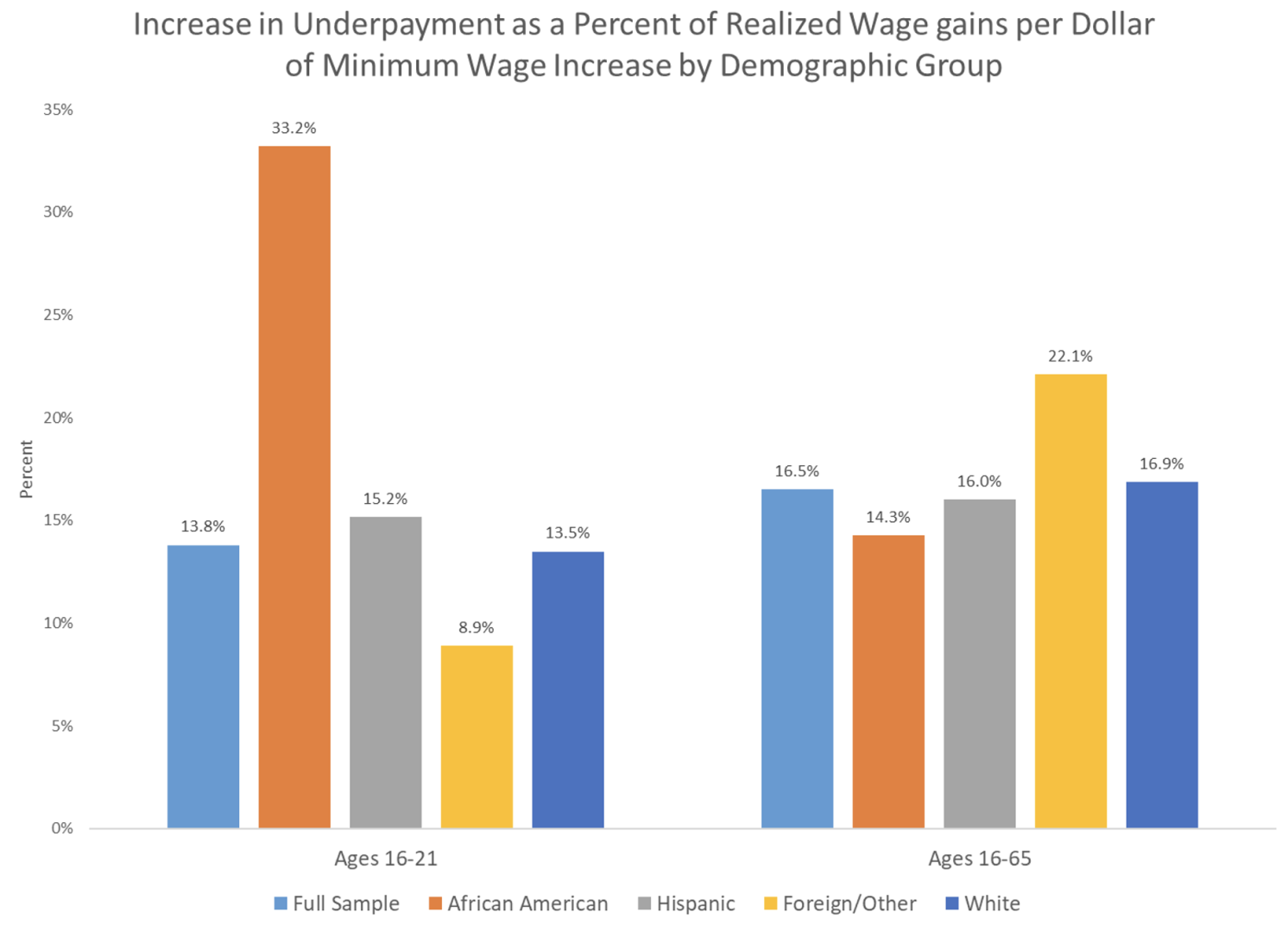Recent research suggests that wages below legally established minimum wages are surprisingly prevalent. This column reviews ‘wage theft’ in the US and its impact on the wage gains workers might otherwise enjoy. Most firms comply with increases in the minimum wage, especially when they have time to plan for the increase, but evasion and avoidance are also qualitatively important features of the low-wage labour market. Young African American workers experience the largest erosion of their potential wage gains following a minimum wage increase. Whether greater enforcement would improve the welfare of low-wage workers, however, remains an open question.
Minimum wages remain of great interest to economists because their employment effects are contested and because they shed light on important issues in the labour market, like the degree to which it is competitive. They are also a perennial policy issue. The most recent example is the decision of many countries and US states to substantially increase their wage floors in response to the tight labour markets and rapid nominal wage inflation of the past two years.
As with any regulation, it is important for both economists and policymakers to understand compliance to holistically evaluate minimum wages. Recent research suggests that wages below legally established minimum wages are surprisingly prevalent (Bhorat et al. 2017, Goraus‐Tańska and Lewandowski 2019, Rani et al. 2013). Much of this research further finds that when wage floors are higher than average wages, estimated employer compliance rates tend to be lower.
Declines in compliance in the wake of minimum wage increases raise several questions of relevance to policymakers. First, how prevalent is noncompliance and how much does it reduce the magnitude of the wage gains workers might otherwise enjoy? Second, are the costs of noncompliance borne disproportionately by workers from disadvantaged groups? Third, to what extent is noncompliance a response by firms to mitigate the need for more drastic changes like reductions in employment?
The prevalence of sub-minimum wage payment following minimum wage increases
In our paper (Clemens and Strain 2022), we attempt to better understand minimum wage compliance by studying compliance on the margin. Specifically, we estimate the increase in sub-minimum wage payment – i.e. ‘wage theft’ – following changes in the minimum wage.
Among relatively younger hourly wage workers (ages 16 to 25) in the US, we estimate that a one dollar increase in the minimum wage is associated with a 29 cent increase in wages and a 3.6 cent increase in sub-minimum wage payment. Across a number of analyses and population sub-samples, increases in sub-minimum wage payment following minimum wage increases range between 10% and 20% of the magnitude of realised wage gains.
This evidence leads us to conclude that most firms comply with increases in the minimum wage, but that evasion and avoidance are also qualitatively important features of the low-wage labour market.
The extent to which employers have time to plan for a minimum wage increase appears to have an effect on compliance. We find that minimum wage increases from new legislation are associated with substantially larger increases in sub-minimum wage payment than minimum wage increases that come about due to automatic inflation indexing, which has been adopted by a number of US states. The latter increases are regular and forecastable, giving firms more time to adapt. This may increase compliance, with firms adjusting to the increase in labour costs along other margins, potentially including employment (Brummund and Strain 2020). Similarly, we find that, for relatively small minimum wage increases, noncompliance rises for 2 to 3 years and subsequently declines. This suggests that firms may turn to noncompliance as a part of their short-run response but over time adopt alternative strategies to absorb or otherwise adapt to the rise in wages.
Which groups are most impacted by sub-minimum wage payment following minimum wage increases?
Which workers are affected the most by sub-minimum wage payment? In a second paper (Clemens and Strain 2023), we study whether sub-minimum wage payment varies across demographic groups. By and large, we find that the bite of underpayment is similar for workers of different ages and of different racial and ethnic groups. Put differently, in the wake of minimum wage increases, increases in underpayment tend to amount, as mentioned above, to between 10% and 20% of the realised wage gains.
That said, we do find some notable differences among different demographic groups. Among young workers (ages 16 to 21), we find that a one dollar increase in the minimum wage increases the wages of (non-Hispanic) African American workers by 28 cents and increases underpayment by 9.4 cents – the magnitude of the underpayment is 33.2% of the magnitude of the wage increases. In contrast, among the full sample of young workers, underpayment amounts to 13.8% of realised wage gains. Relatively young African American workers thus emerge in our analysis (Figure 1) as the primary group for which this ratio is unusually large: increases in underpayment erode an unusually large fraction of the wage gains these workers might otherwise have experienced.
Among a broader sample (those aged 16 to 65), variations in the share of wage gains that are eroded by underpayment are modest, as also shown in the figure. Of note in this broader sample is that Hispanic workers are disproportionately impacted by both the wage increases and increases in underpayment that occur in the wake of minimum wage increases, such that the ratio is ultimately similar to what we see for the full sample.
Figure 1 Increase in underpayment as a per cent of realised wage gains per dollar of minimum wage increase by demographic group


Implications for assessing minimum wage policy
The academic and policy debate understandably emphasises the employment effects of minimum wage increases (e.g. Clemens and Strain 2021). But firms are likely to respond to minimum wage increases across a variety of margins, including the generosity of the benefit packages they offer to workers, the amount of exertion they require of workers on the job, and perhaps even schedule irregularity (Clemens 2021, Dworsky et al. 2022, Meiselbach and Abraham 2023, Ku 2022, Coviello et al. 2022, Clemens and Strain 2020). Noncompliance is an additional method to which firms might turn when adjusting to increases in mandated labour costs.
This leaves open the question as to whether greater enforcement measures would improve the welfare of low-wage workers broadly, and of members of disadvantaged groups, who may be disproportionately impacted by wage theft.
On the one hand, more aggressive enforcement would likely reduce the magnitude of sub-minimum wage payment relative to realised wage gains. On the other hand, to the extent that firms resort to noncompliance to avoid more severe adjustments like reducing their employee headcount, ramped-up enforcement measures may reduce job opportunities among low-wage workers. The effect of the former would be to increase earnings; the effect of the latter would be to decrease them. This trade-off has been considered in recent work (Garnero and Lucifora 2022). Additional analyses of interest have highlighted connections between minimum wages and compliance with tax law (Gavoille and Zasova 2023a,b).
Analyses of optimal minimum wages can approach the issue from a number of perspectives (Ahlfeldt et al. 2022, Dustman et al. 2021). Apart from the welfare effects of more aggressive enforcement, an additional welfare consideration is broader, pitting the rule of law against economic efficiency. The rule of law requires that regulations be followed and that low-wage workers be paid at minimum the wages they are legally owed. That said, some of the wage theft in the low-wage labour market may be economically efficient if it enables voluntary and mutually beneficial transactions between workers and firms. In this sense, noncompliance with minimum wage regulation may blunt the regulation’s distortionary employment effects.
We highlight this trade-off not as a rationalisation for noncompliance, but instead to argue that policymakers (and economists) should better appreciate the tension between economic efficiency and the rule of law that arises with minimum wage regulation. Any holistic assessment should include this consideration.
Source : VOXeu



































































